プロジェクトProjects
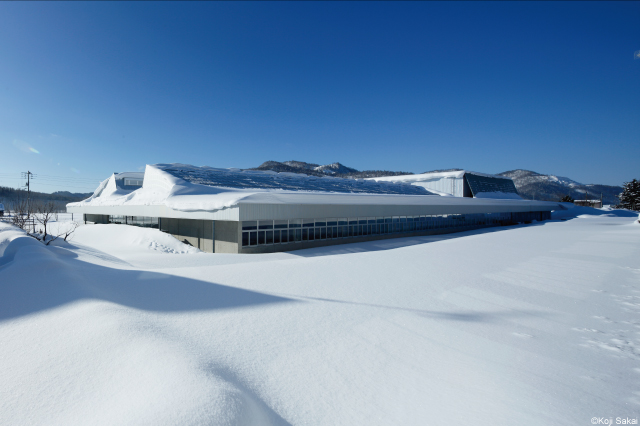
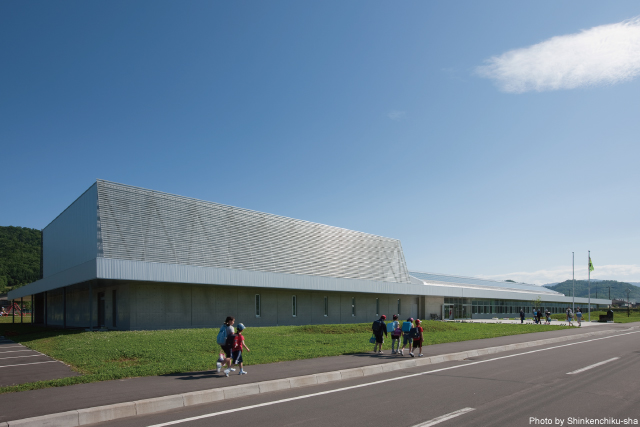
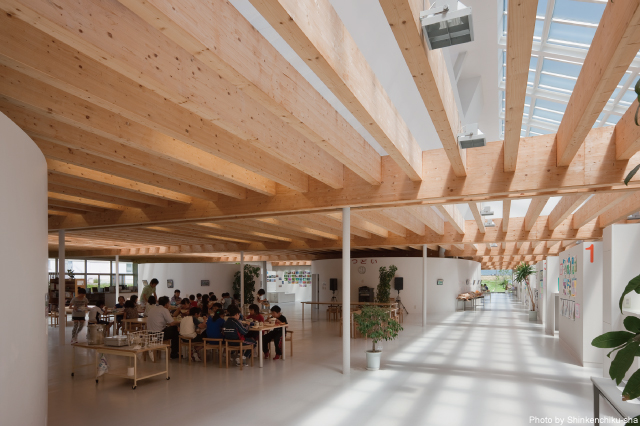
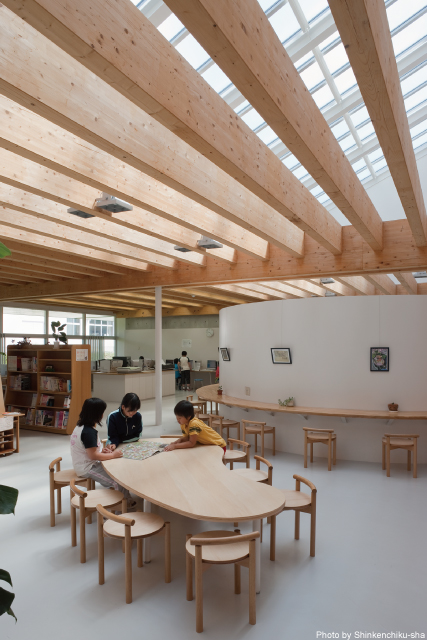
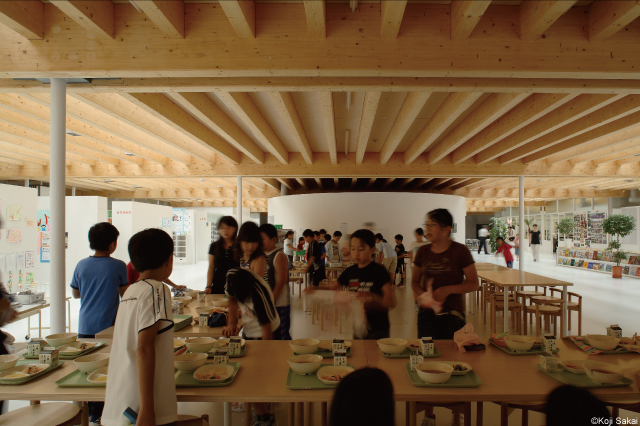
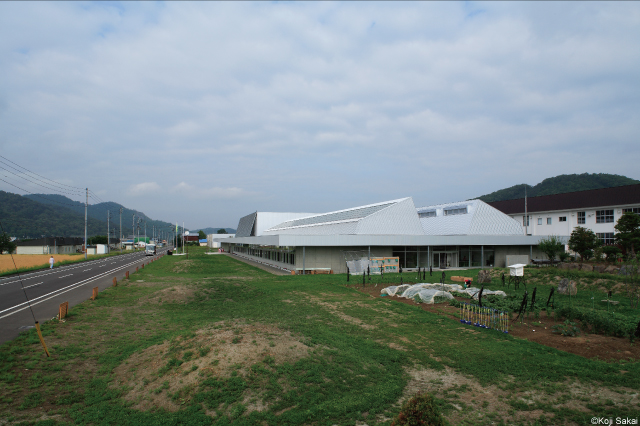
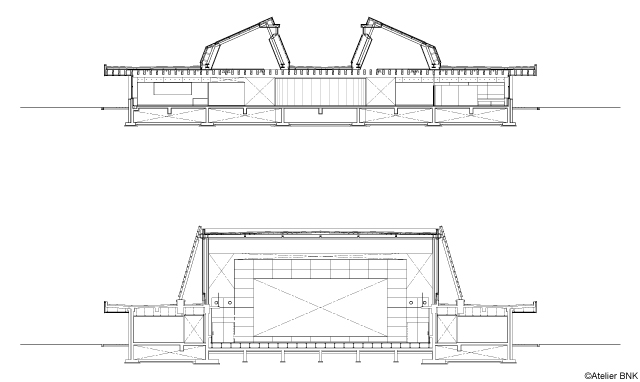
糸魚小学校
2008
北海道士別市
構 造:木造 + 鉄筋コンクリート造 + 鉄骨造
階 数:地上1階
延床面積:3,893㎡
金箱構造設計( 構造設計 )
北方建築総合研究所( 環境アドヴァイザー )
アトリエブンク + 総合設備計画( 設備設計 )
アトリエブンク + カンディハウス( 家具 )
1学年10 人程度の小規模小学校である。町村合併以前は朝日町といわれたこの地区では、歴史ある小学校を新しくすることで、まちのシンボルを次代に残していくことが企画された。積雪寒冷地における学校建築では屋外の活動が大きく制限されるため、ほとんどの活動が内部で完結する必要がある。また10 数人の教師がひとつのチームとなって子どもたち全員と向き合うような、小規模校ならではの家族的な一体感をつくることも重要なテーマであった。このことから体育館と校舎を一体化させたコンパクトな平面計画とし、廊下などの移動専用空間を教育活動のための空間として充てる計画を行うことで、十分な内部空間を獲得した。
一方、この地にふさわしいサスティナブル性を追求した。コンパクトな形状として暖房負荷削減を重視しつつ、自然光や通風の取得、雪庇に対する軒や有孔スクリーン設置を試みた。地元で産出されるエゾマツ・トドマツ集成材による大屋根を実現するために、RC・S造とのハイブリッドとすることで、木材部分の応力負担を軽減する工法とした。屋根躯体の軽量化による壁量の減少は、平面計画の自由度を高めるとともに、光や空気の流れを阻害しない空間となった。
集成材の隙間から落ちる自然光は、床面に多様な濃淡を生み出す。設計では光の分布シミュレーションをもとに綿密な家具レイアウトを行った。季節や時間に応じて変化する光の下、生活の場を自由に移動できるゆとりを持たせた。
公共建築協会公共建築賞優秀賞
日本建築学会作品選奨
日本建築学会作品選集2010
新建築2009年9月号
JA76
ディテール 194号
ArchDaily
Itoi Elementary School
2008
Shibetsu-shi, Hokkaido
Structure:W+RC+S
Floor:1 story
Floor Area:3,893㎡
Kanebako Structural Engineers( Structural Design )
Northern Regional Building Research Institute( Environmental Adviser )
Atelier BNK+Sogo Consultants( Mechanical & Electrical Engineering )
Atelier BNK+Conde House( Furniture )
This is a small elementary school with approximately ten students in each grade. A merger with neighboring towns has led to the disappearance of the former name of the town, Asahi. However, the school has a long history, and this project aimed to renew the school building as a symbol of the town for future generations. Our design had to take into account the fact that activities outside of the school buildings are extremely limited in cold, snowy areas and most activities have to be done indoors. Also, it was important to create a family-like sense of unity unique to a small school in which a dozen or so teachers form one team and engage with all of the children. Therefore, our design comprised a compact floor plan that integrated the gymnasium into the school building, and adequate interior space was obtained by using corridors and other areas as teaching space rather than having them solely dedicated to movement.
We also sought to make the building sustainable in a way that is appropriate to the region. While focusing on reducing the heating load by making the building compact, our design allows natural sunlight and cross-ventilation in the building. Also, eaves and perforated screens were installed to prevent overhanging snow. In order to build a large roof using locally-produced laminated lumber of Jezo spruce and Sakhalin fir, a hybrid, reinforced concrete and steel structure that reduces the load on the wood sections was employed. Lightening the framework of the roof reduced the required wall volume and, as well as increasing the amount of freedom in the floor plan, created a space in which the light and the flow of air are unobstructed.
Natural light coming through the openings between the laminated lumber creates varying patterns of light and shade on the floor surface. Our design included a detailed plan of the furniture layout based on a simulation of the light distribution; however, it also allows for free movement of the living space as the light changes with the time of day and the seasons.
Public Building Award, Excellence Prize
Annual Architectural Design Commendation, Architectural Institute of Japan
2010 Selected Architectural Designs of the Architectural Institute of Japan
Shinkenchiku Sep.2009
JA76
Detail No.194
ArchDaily
